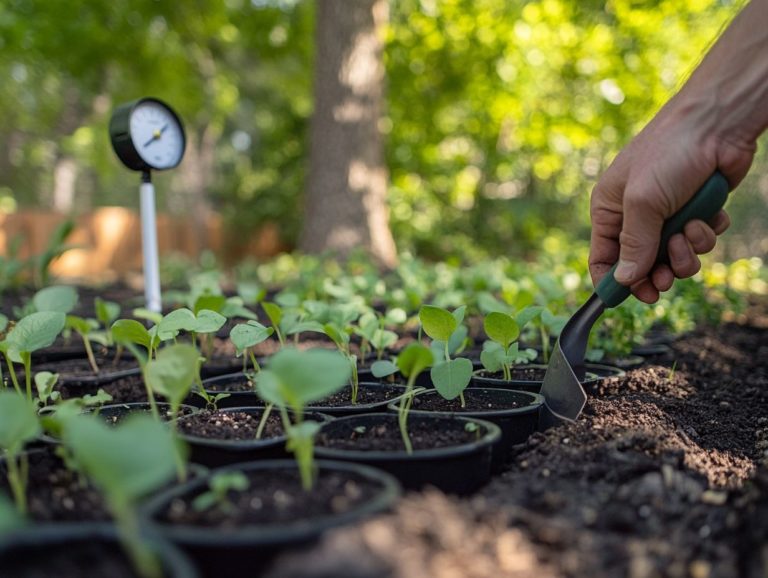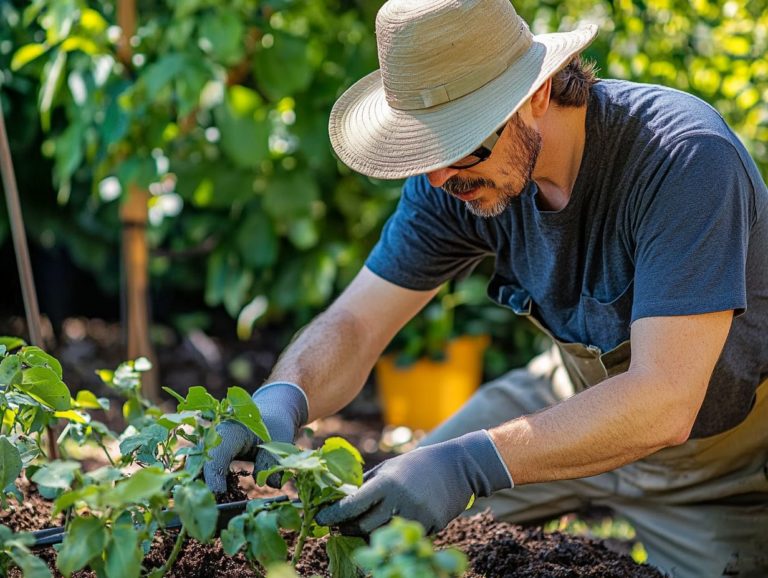Creating a Wildlife-Friendly Drought Garden
Drought gardens offer a remarkable opportunity to cultivate beauty while also supporting local wildlife, even in the driest conditions. This makes them an ideal choice for those interested in gardening.
Learn how to create a drought-tolerant oasis that flourishes with minimal water and attracts diverse creatures, including beneficial pollinators like bees and butterflies. From selecting the right plants to employing smart watering techniques and crafting inviting habitats, this guide equips you with everything you need to transform your garden into a sanctuary for both nature and yourself.
Delve into the joys and benefits of nurturing a wildlife-friendly drought garden, which enhances local ecosystems and promotes the variety of life!
Contents
- Key Takeaways:
- Benefits of a Wildlife-Friendly Drought Garden
- Designing Your Drought Garden
- Creating a Habitat for Wildlife
- Maintaining Your Drought Garden
- Dealing with Drought-Related Challenges
- Frequently Asked Questions
- What is a Wildlife-Friendly Drought Garden?
- Why is it important to create a Wildlife-Friendly Drought Garden?
- What are some key elements to consider when designing a Wildlife-Friendly Drought Garden?
- What are some essential plants to include in a Wildlife-Friendly Drought Garden?
- How can I conserve water in a Wildlife-Friendly Drought Garden?
- Are there any resources available to help me create a Wildlife-Friendly Drought Garden?
Key Takeaways:

- A drought garden thrives in low-water conditions.
- A wildlife-friendly drought garden beautifies your space and is easy to maintain.
- Focus on drought-tolerant plants and water-saving techniques to create a wildlife habitat.
What is a Drought Garden?
A drought garden is your ticket to creating a beautifully designed green space that features drought-tolerant, native plants. This approach to creating a drought-resistant garden conserves water and nurtures local wildlife, providing a sustainable way to enjoy your backyard.
By choosing plant species that flourish in low-water conditions, you can reduce reliance on chemical pesticides while enhancing biodiversity the variety of different life forms. This is essential for urban areas in the UK, where environmental challenges are increasingly pressing.
Think of a drought garden as a sanctuary for a variety of pollinators, birds, and small mammals. It makes a significant contribution to the local ecosystem, especially in areas facing environmental challenges. In this carefully curated space, native plants like lavender, sedum, and coneflower thrive with minimal water requirements and adapt seamlessly to the regional climate, ensuring sustainability. To learn more about enhancing these gardens, check out this guide on how to promote biodiversity in drought gardens.
This thoughtful approach helps create a balanced environment, drawing in beneficial insects while keeping invasive species at bay unwelcome guests that threaten local biodiversity and the delicate balance of the natural world. By prioritizing these native plants, you can play a pivotal role in promoting ecological resilience. Plus, you ll enjoy the perks of a low-maintenance and visually stunning landscape that flourishes even during dry spells.
Benefits of a Wildlife-Friendly Drought Garden
By designing a wildlife-friendly drought garden, you unlock a wealth of advantages. Not only do you promote biodiversity, but you also attract essential pollinators like bees and butterflies. For tips on creating such a garden, check out this guide on establishing a drought-tolerant garden, which fosters a thriving ecosystem in your backyard.
You will provide vital habitat features that support a variety of wildlife species, including hedgehogs and birds in need of nourishment. Your garden becomes a sanctuary for nature. It s not just a beautiful space.
Attracting and Supporting Local Wildlife
Attracting and supporting local wildlife in your drought garden is achievable through the thoughtful selection of native plants. These plants offer food and shelter for various species, including hedgehogs and birds, while enhancing the overall health of your ecosystem.
This enhances your garden’s beauty and boosts ecosystem health. By incorporating a diverse array of flowering shrubs and ground cover plants, you can create a vibrant habitat that entices colorful pollinators like butterflies and bees. It also provides essential nesting sites for small mammals, enriching your garden’s biodiversity.
A diverse ecosystem fosters balance, where different plants support one another and the wildlife that depends on them, leading to a more resilient garden. Adding features such as water sources, native wildflowers, and small rocky outcroppings can further attract a variety of animal species. This creates a habitat that supports local wildlife and promotes ecological balance. This approach ensures a sustainable environment for feeding and resting, allowing your garden to thrive in harmony with nature.
Designing Your Drought Garden
Designing your drought garden requires a thoughtful approach to backyard design, emphasizing sustainability and resilience against environmental challenges. Consider how to create a sustainable drought garden by focusing on selecting drought-tolerant plants and integrating features that help wildlife.
This creates a sustainable ecosystem that thrives despite environmental challenges.
Choosing Drought-Tolerant Plants

When selecting drought-tolerant plants for your garden, consider native species like California fuchsia, known for its vibrant blooms, and Narrow-leaf milkweed, crucial for supporting monarch butterfly populations. These plants are perfectly suited to local conditions and provide vital resources for wildlife.
These remarkable plants develop deep root systems, allowing them to draw moisture from lower soil levels. They feature thick or waxy leaves that minimize water loss, making them ideal for sustainable gardening. By incorporating these native species into your landscape, you bolster its resilience and create a haven for local pollinators like bees and butterflies.
For instance, California fuchsia s vibrant flowers are not just a feast for the eyes, but also serve as a nectar source for hummingbirds, fostering a thriving ecosystem. Similarly, Narrow-leaf milkweed sustains monarch butterfly populations by providing essential habitat for their larval development, showcasing the beautiful interconnectedness of flora and fauna in your garden.
Incorporating Water-Saving Techniques
Incorporating water-saving techniques into your drought garden is essential for effective drought management and water conservation, vital for plant health and wildlife habitats. By embracing compost and other eco-friendly practices, you significantly reduce your reliance on external water sources.
Consider methods like collecting rainwater to use in your garden; this allows you to capture and utilize natural precipitation, maximizing your resources and supporting your ecosystem’s overall health. Employing mulching techniques conserves moisture in the soil and helps maintain stable temperatures, benefiting plant health.
Exploring smart irrigation systems lets you establish precise watering schedules, ensuring every drop counts while minimizing evaporation and runoff. Implementing these strategies promotes sustainable gardening and helps create a resilient landscape that thrives in challenging conditions.
Creating a Habitat for Wildlife
Creating a habitat for wildlife in your drought garden involves thoughtfully integrating various features, including feeders and water sources that cater to different species’ needs. Adding feeders, water sources, and shelters attracts diverse species and enriches the ecological balance of your backyard ecosystem.
This deliberate approach fosters biodiversity and transforms your garden into a vibrant refuge for local wildlife, enhancing the natural beauty of your outdoor space.
Adding Feeders, Water Sources, and Shelter
Incorporating feeders, water sources, and shelter in your drought garden is vital for nurturing local wildlife, such as hedgehogs and birds. This ensures they have the resources to flourish in their natural habitats.
By adding various feeders from tube feeders designed for smaller songbirds to platform feeders that attract larger species you cultivate an inclusive environment that meets different dietary preferences, benefiting both feeding birds and local pollinators. A birdbath or shallow water dish not only quenches their thirst but also creates a bathing haven, promoting hygiene and overall health.
Integrating natural shelters, like brush piles or native plant cover, offers essential protection and nesting sites for various species, supporting the diverse wildlife that frequents your garden. Providing these key elements transforms your garden into a vibrant ecosystem, fostering a harmonious relationship between yourself and nature while enhancing the beauty of your outdoor space.
Maintaining Your Drought Garden
Maintaining your drought garden is essential for its longevity. You need to adopt effective watering practices and manage soil health meticulously. This is vital for sustaining both plant life and local wildlife. By doing so, you ensure that your ecosystem remains robust and viable, even in the face of dry conditions.
Proper Watering and Care

Proper watering and care are essential for effective drought management in your garden. Balancing water use while nurturing the health of your plants, soil, and the wider ecosystem is crucial.
Establish a consistent watering schedule tailored to your garden’s specific needs. This can significantly enhance its growth and vitality. Typically, it’s best to water deeply and infrequently. This allows the soil to fully absorb moisture and encourages roots to reach deeper. Methods like drip irrigation (a way to water plants slowly using a hose with small holes) or soaker hoses are excellent for conserving water, delivering moisture directly to the roots.
Watch for signs of overwatering like yellowing leaves or wilting as well as indicators of underwatering, such as browning tips or drooping stems. This vigilance helps you fine-tune your watering regimen. By implementing these practices, you support plant health and foster efficient soil management techniques that benefit your entire garden ecosystem.
Dealing with Drought-Related Challenges
Navigating the challenges posed by drought demands a proactive strategy. Preserve ecological balance and enhance biodiversity in your garden, especially in the UK. You can easily create a thriving garden by using methods like composting. This enriches your soil, and thoughtfully adjusting your plant selections ensures a resilient ecosystem.
Common Issues and Solutions
Common issues in drought gardens include wilting plants, diminished wildlife activity, and soil erosion. You can effectively address these with practical solutions like mulching and diversifying plant species.
Gardening under drought conditions presents challenges. The stress on your plants intensifies, often resulting in stunted growth and disappointing yields. To counter this, consider incorporating deep-rooted species that can tap into moisture found beneath the surface.
Utilize drip irrigation to improve water efficiency. This ensures each plant receives the moisture it craves without unnecessary waste. Create a rain garden to collect runoff and support local wildlife, restoring some ecological balance even during tough times.
Frequently Asked Questions
What is a Wildlife-Friendly Drought Garden?
A wildlife-friendly drought garden is designed to attract and support local wildlife while conserving water during drought.
Why is it important to create a Wildlife-Friendly Drought Garden?

Creating a wildlife-friendly drought garden benefits the environment and local wildlife, while also conserving water resources during drought conditions.
What are some key elements to consider when designing a Wildlife-Friendly Drought Garden?
Key elements include choosing native plants, providing shelter and food sources for wildlife, using sustainable watering methods, and reducing the need for pesticides and fertilizers.
What are some essential plants to include in a Wildlife-Friendly Drought Garden?
Essential plants are those native to your region, providing food, shelter, and nesting sites for wildlife. Include native grasses, shrubs, and wildflowers.
How can I conserve water in a Wildlife-Friendly Drought Garden?
You can conserve water in a Wildlife-Friendly Drought Garden by using mulch and choosing drought-resistant plants. For detailed guidance on creating this type of garden, check out how to create a pollinator-friendly drought garden. Additionally, collect rainwater and use a system that delivers water directly to the roots of plants.
Avoid over-watering your garden. Water during cooler times of the day to reduce evaporation.
Are there any resources available to help me create a Wildlife-Friendly Drought Garden?
Many resources can help you create a Wildlife-Friendly Drought Garden. Local gardening centers, conservation organizations, and online guides on integrating wildlife habitats in drought gardens offer a wealth of information.
Consult a professional landscaper or join a community gardening group for practical tips and advice.
Start your garden today and make a positive impact on nature!






